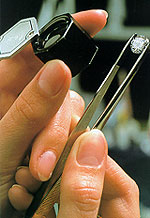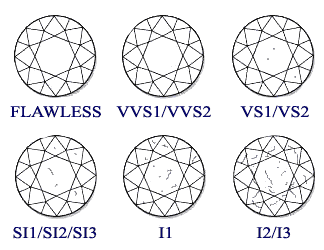

 |
 |
 |
a trend creation |
 |
 |
 |
| History | Cut |
Color |
Clarity |
Carat |
Famous |
Color Stone |
Birth Stone |
Care | How to Buy |
CLARITY

How know to clear be
the
stone?
Clarity ranges from flawless
(perfect) to I (included). Here is a chart:
Flawless: perfect inside and out
Internally.
Internally
flawless: may
have minor blemishes on
the outside
VVS1,
VVS2: have very
very small
inclusions.
VVS1:
inclusions can
only be seen
through the pavilion.
VVS2: inclusions are more visible.
VS1,
VS2: have very
small inclusions.
VS1:
inclusions are
harder to see
than
VS2.
SI1, SI2, SI3: have
small
inclusions
I1,
I2, I3: have
inclusions visible to
the naked eye Clarity

Clarity refers to the degree
to which a diamond is devoid of inclusions and imperfections in the
crystal.
When graded for clarity, diamonds are placed into one of five main
categories
or groups, which then are further divided into subcategories.
The standard clarity grade
categories are as follows:
FL
and IF (flawless) FL (flawless) and IF (internally flawless) are exceptionally rare diamonds,
and in fact there
are those who claim that they do not really exist. Such stones,
especially when
their color is also of a high grade, are often defined as
"collectors" or "investment stones." VVS1 and VVS2 (very,
very small inclusions) Diamond carrying such
grades generally are considered top-of-the line. Such diamonds carry
inclusions
and imperfections that are very difficult to spot, even under the
magnification
of a 10X loupe (a jeweler's magnifying glass that enlarges the image of
the
diamond by 10 times). VVS1 is the better of the two grades.
VS1 and VS2 (very small inclusions) Such diamonds are also
considered exclusive. Here, inclusions and imperfections are still
practically
invisible to the naked eye, but they can be detected with relative ease
by a
10X loupe. VS1 is the higher of the two grades SI1 and SI2
(small inclusions) In most quality jewelry stores, the
majority of the diamonds sold belong to the SI clarity grade group,
with an SI
stone considered by many to be the best compromise between cost and
clarity.
The inclusions and imperfections are difficult to detect with the naked
eye,
and normally do not detract from the stone's "face up" appearance.
SI1 is the better grade of the two.
I1,
I2 and I3 (included) With diamonds
that fall in the “I” grade group, the inclusions and imperfections can
be seen
relatively easily with the naked eye. Obviously, these goods are
generally less
expensive than their higher-grade counterparts are. Often, large stones
of “I”
clarity are purchased by those who value the size of a stone above
anything
else. I1 is the highest of the three, followed by I2.
Refers picture to the
presence of inclusions in a diamond.


Inclusions are natural
identifying characteristics such as minerals or fractures, appearing
while
diamonds are formed in the earth. They may look like tiny crystals,
clouds or
feathers. To view inclusions, jewelers use a magnifying loupe. This
tool allows
jewelers to see a diamond at 10x its actual size so that inclusions are
easier
to see. The position of inclusions can affect the value of a diamond.
There are
very few flawless diamonds found in nature, thus these diamonds are
much more
valuable. Inclusions are ranked on a scale of perfection, known as
clarity,
which was established by the Gemological Institute of
The clarity of a diamond
refers to how clear, or "clean" the diamond is. The more
"clean" the diamond, the higher the price. Most diamonds have
"imperfections" in them. The clarity scale is a measure of the
severity of those imperfections or "inclusions" as it is known in the
trade. For example, a deep break in a diamond which is not that visible
when
you look at the stone face-up, could sometimes have a greater impact on
the
clarity of a stone, than a small black crystal which you can see very
clearly
face-up
How much does
"clarity" affect cost?
The effect of all the
different properties of Diamond on Cost is discussed in more detail in
the Cost
section. For clarity, let's take a typical Diamond for an example, and
see what
happens when we take it through different clarity grades. Let's start
with a
1.00-carat Diamond of G color and SI1 Clarity. If you move up to a VS1,
you
will pay approximately an extra $1000 per carat. Move up to VVS1, the
increase
will be approximately $700 per carat ($1,000+700=1,800). Improve the
clarity to
IF and the increase will be approximately $700 per carat.
